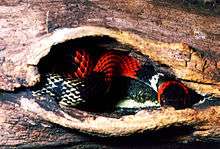Oxyrhopus guibei
| Oxyrhopus guibei | |
|---|---|
 | |
| Scientific classification | |
| Kingdom: | Animalia |
| Phylum: | Chordata |
| Subphylum: | Vertebrata |
| Class: | Reptilia |
| Order: | Squamata |
| Suborder: | Serpentes |
| Family: | Colubridae |
| Subfamily: | Xenodontinae |
| Genus: | Oxyrhopus |
| Species: | O. guibei [1] |
| Binomial name | |
| Oxyrhopus guibei Hoge and Romano, 1977 | |
| Synonyms | |
| |
Oxyrhopus guibei is a species of colubrid snake. It is often called the false coral snake,[3][4][5] but this common name can refer to any of a long list of other species, genera, and even entire families of snakes.[6][7] Many nonvenomous snakes have evolved coloration that mimics that of venomous true coral snakes, a trait which helps them avoid predation.[8]
Etymology
The specific name, guibei, is in honor of French herpetologist Jean Guibé.[9]
Geographic range
This species is native to central sections of South America, in parts of Bolivia, Brazil, Paraguay, and Argentina.[2]
Conservation status
This species has been described as common[4] to abundant.[3]
Description
It can reach 1 m (3.3 ft)[10] to 1.25 m (4.1 ft) in total length (body + tail).[11] Females can reach much larger sizes than males.[5]
Habitat
Common habitat includes forest edges. It can be found out in the open. The snake is sometimes seen near human activity and habitation, for example, on farms and in backyards.[3]
Behavior
This snake is mostly nocturnal, but is sometimes out basking during the day.[11] It spends most of its time on the ground,[3] but it will climb trees at times.[10]
Diet
Its diet includes rodents, lizards, and other small animals. Rodent prey items include rats (Rattus sp.), the hairy-tailed bolo mouse (Necromys lasiurus), the house mouse (Mus musculus), the small vesper mouse (Calomys laucha),[11] the delicate vesper mouse (Calomys tener), and hocicudos (Oxymycterus sp.).[12] It will eat the lizard Tropidurus itambere and it has been observed taking white-tipped dove nestlings (Leptotila sp.).[11] Lizards it will swallow alive but rodents it often constricts first.[13]
Reproduction
The female lays eggs year-round,[3] but male and female reproductive activity slows around the end of the rainy season.[5] Clutch sizes range from about 3 to 20,[5] with an average size of about 11.[3] Longer females lay more eggs.[5] Eggs are laid in nest sites such as cavities in rock piles and abandoned rabbit burrows.[3] The female abandons the eggs once they are laid.[10]
Enemies
Predators of the species include the laughing falcon (Herpetotheres cachinnans), a bird which specializes in snakes, and Erythrolamprus aesculapii, another species of false coral snake. It has also been observed in the diet of the maned wolf (Chrysocyon brachyurus), which readily eats snakes, including venomous species.[4]
Defensive behavior
The snake performs defensive behaviors when threatened, such as "brusque" thrashing,[10] staying still or rushing to escape, compressing or inflating its body, coiling, hiding its head, or producing a cloacal discharge.[11]
References
- ↑ ITIS (Integrated Taxonomic Information System). www.itis.gov.
- 1 2 Oxyrhopus guibei. The Reptile Database.
- 1 2 3 4 5 6 7 Braz, H., and D.D. Manço. (2011). Natural nests of the false-coral snake Oxyrhopus guibei in southeastern Brazil. Herpetology Notes 4: 187-189.
- 1 2 3 Tozetti, A.M., et al. (2004). Oxyrhopus guibei (false coral snake). Predation. In: Herpetological Review 35 (2): 179.
- 1 2 3 4 5 Pizzatto, L., and O.A.V. Marques. (2002). Reproductive biology of the false coral snake Oxyrhopus guibei (Colubridae) from southeastern Brazil. Amphibia-Reptilia 23 (4): 495-504.
- ↑ Aniliidae. Integrated Taxonomic Information System.
- ↑ Erythrolamprus. Integrated Taxonomic Information System.
- ↑ Brodie, E.D., and F.J. Janzen. (1995). Experimental studies of Coral Snake mimicry: Generalized avoidance of ringed snake patterns by free-ranging avian predators. Functional Ecology 9: 186-190.
- ↑ Beolens, Bo; Michael Watkins; Michael Grayson. (2011). The Eponym Dictionary of Reptiles. Johns Hopkins University Press. Baltimore. xiii + 312 pp. ISBN 978-1-4214-0135-5. ("Guibé", p. 111.)
- 1 2 3 4 Kraus, J.E. (2005). Fauna and flora of the campus of the Cidade Universitária Armando de Salles Oliveira. EdUSP. 2005: 70.
- 1 2 3 4 5 Sazima, I., and A.S. Abe. (1991). Habits of five Brazilian snakes with coral-snake pattern, including a summary of defensive tactics. Studies on Neotropical Fauna and Environment 26: 159-64.
- ↑ Alencar, L.R.V., et al. (2009). Oxyrhopus guibei (False Coralsnake). Diet. In: Herpetological Review 40 (3): 357-358.
- ↑ Oliveira Andrade, R., and R.A.M. Silvano. (1996). Feeding behavior and diet of the Oxyrhopus guibei Hoge & Romano (Serpentes, Colubridae). Revista Brasileira de Zoologia 13 (1): 143-150.
Further reading
- Hoge, A.R., and A.R.W.D.L. Romano. (1977). Description of a new subspecies of Oxyrhopus Wagler (Serpentes, Colubridae). Memórias do Instituto Butantan 40/41: 55-62. (Oxyrhopus trigeminus guibei, p. 58.)
- Zaher, H. & Caramaschi, U. 1992. Sur le statut taxinomique d’Oxyrhopus trigeminus et O. guibei (Serpentes, Xenodontinae). Bulletin du Muséum national d’Histoire naturelle, (4)14a(3-4):805-827.